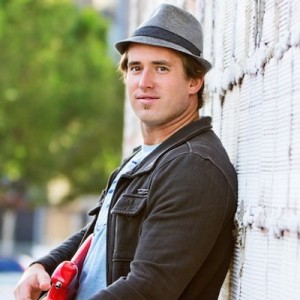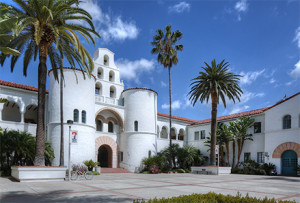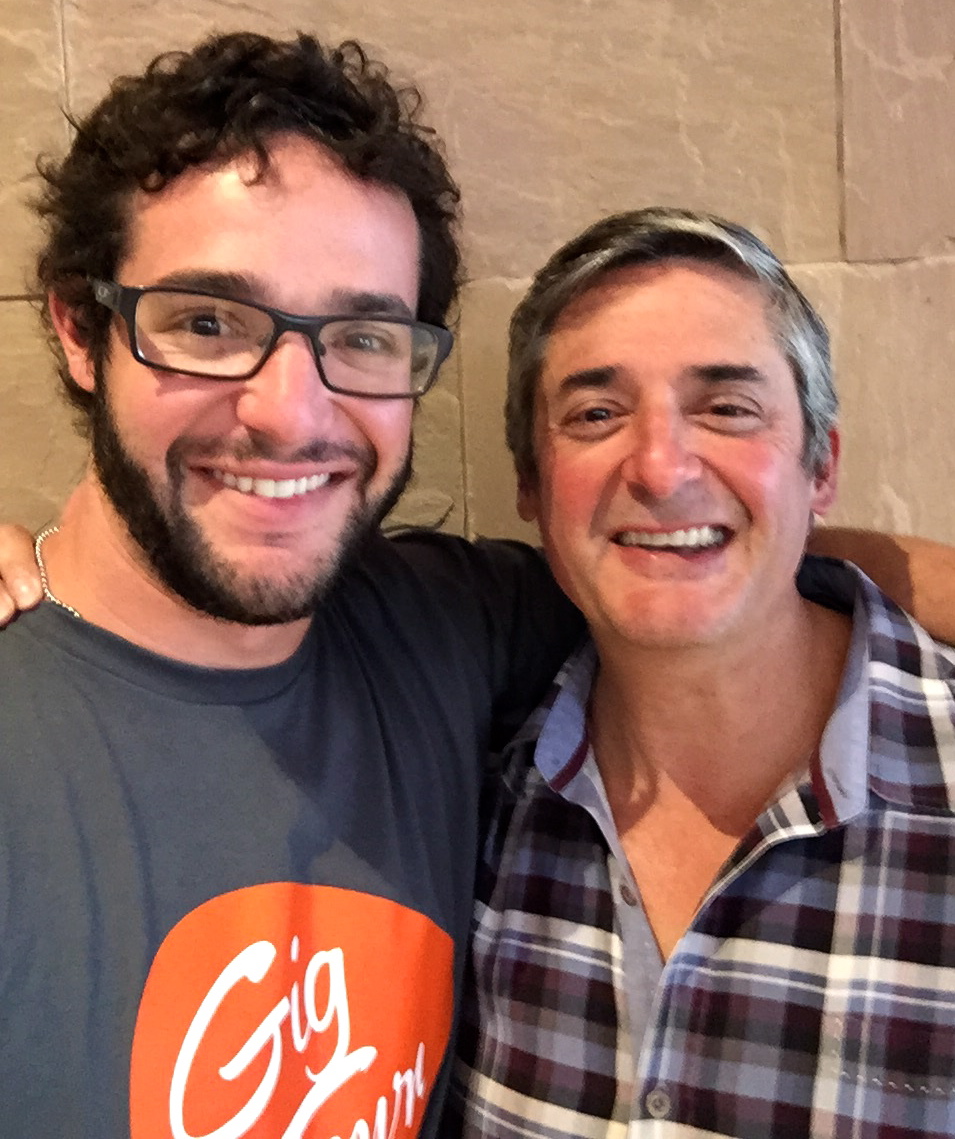Daily Business Report-Dec. 12, 2014
Former Qualcomm Vice Chairman Steve Altman and his son, Andy, have launched a new company developing a mobile application for booking local musicians.
Former Qualcomm Vice Chairman
Launches New Music Gig With Son
Steve Altman, chief architect of Qualcomm Inc.’s technology licensing strategy, retired in January from his post as vice chairman, but he’s got a new gig in town that he’s launching with son Andy.
It’s called, appropriately, GigTown LLC, a company developing a new mobile application designed to simplify the process of booking live local musicians for parties, events and other gatherings.
The company announced this week that it is conducting a large-scale trial of the app. After the trial phase, it would be made commercially available first in San Diego and then move to other major music markets throughout the U.S. in 2015.

The app allows users to easily browse musicians, listen to their featured songs and view video footage of performances. Users simply set their location, choose the date and time of the event, select an available artist, and submit a booking request.
Altman, who spent 25 years with Qualcomm, and Andy, who is in the JD/MBA program at the University of San Diego, are both passionate fans of local music. They saw a need for a simple and easy way to discover local artists and hire them to perform.
“We’re thrilled to launch GigTown and propel local music and the musicians behind it,” said Andy. “People have the perception that booking music is complex, time-consuming, and expensive. However, with GigTown, it’s easier than ever to discover and book talented local musicians.”
GigTown was developed to put the power of booking in the hands of consumers. The founders say it sets itself apart with its simplicity and clear pricing structure. Artists set their own hourly rates, which includes setup, takedown, basic sound equipment and tip, so users know exactly what they will pay with no additional fees.
Independent GigTown musicians range from solo guitarists to 12-piece bands and vary widely in price, from $25 per hour to over $4,000 per hour. From signed Pacific Record artists to newly-discovered talent, the diversity of musicians offered on GigTown is endless, according to the founders.
“I always enjoyed discovering new artists by watching shows like ‘The Voice’ and ‘American Idol’”, said Steve Altman. “As amazingly talented as these musicians are, I found it equally amazing that they were unable to earn enough money in the music profession to follow their passion.
“When Andy and I thought about the idea behind GigTown, we knew we were onto something. By making it easier for music fans to discover and book local music, the market for live music expands greatly, enabling talented and creative musicians to pursue their dreams.”
San Diego musician Ryan Hiller serves on the Musician Advisory Board for GigTown. He said he is confident that the app has the power to be a disruptive force in the music industry. “This app will connect musicians with fans in a totally unprecedented and revolutionary way,” said Hiller.
Following the trial phase, the app will be available in the iOS App Store mid-January and will be available for Android shortly after.
Altman joined Qualcomm in 1989 as a young lawyer, moving up from general counsel, head of technology licensing, president of the company and then vice chairman. He played a key role in getting the company’s CDMA technology established in the market. It is now used in many of today’s 3G and 4G smartphones. Through the first nine months of Qualcomm’s fiscal year, technology licensing made up $5.9 billion of the company’s $18.3 billion in revenue.

San Diego Miramar College Among Fastest
Growing Community Colleges in the U.S.
San Diego Miramar College ranks on the Top 20 list of fastest growing community colleges in the country among those with more than 10,000 students, according to a new Community College Week survey.
The survey, released Dec. 9, places San Diego Miramar College as the 17th fastest growing community college in the nation, with enrollment in the fall of 2013 rising 4.7 percent to 11,891 from the previous fall semester.
“San Diego Miramar College is pleased to be ranked among the fastest-growing community colleges in the nation,” said Miramar College President Patricia Hsieh. “With leading programs such as the Southern California Biotechnology Center, the Advanced Transportation and Energy Center, and the San Diego Regional Public Safety Training Institute, we have established the college as a magnet for excellence.”
Miramar College was founded in 1969 as the Miramar Regional Occupation Training Center, a $1-million complex for police and fire cadets. Arts and sciences programs were added in 1973, and in 1975, the Miramar Regional Occupation Training Center was renamed San Diego Miramar College.
The college offers nearly 150 certificates, associate degrees, and comprehensive transfer programs while partnering with local industry and governments to prepare students for in-demand and well-paying jobs.
SDSU Applications at an All-Time High

For the fourth year in a row San Diego State University has received a record number of applications. The application period for fall 2015 closed on Nov. 30 with 81,080 freshman and undergraduate transfer student applications. That is an increase of more than 2 percent from last year’s record 79,135 applications for fall 2014.
Among the fall undergraduate applications are 58,193 first-time freshmen and 22,816 upper division transfer students, up 4 and 6 percent respectively over last year.
The 2014 class of freshmen for the San Diego campus is the highest-achieving in the history of the university. Among the 4,978 first-time freshmen this year, the average high school GPA is 3.69 with an average SAT score of 1115, up from 3.61 and 1106 the year before. The incoming class is also highly diverse; 52.9 percent of first-time freshmen are students of color.
SDSU has improved in national rankings, moving up 34 spots from No. 183 in 2011 to No. 149 in this year’s U.S. News and World Report’s list of national universities.
Fall 2015 applicants can expect notification of acceptance by March 2015.
Obese Children’s Brains More Responsive to Sugar
A new study led by researchers at UC San Diego School of Medicine finds that the brains of obese children literally light up differently when tasting sugar. Published online in International Journal of Obesity, the study does not show a causal relationship between sugar hypersensitivity and overeating but it does support the idea that the growing number of America’s obese youth may have a heightened psychological reward response to food.
This elevated sense of “food reward” — which involves being motivated by food and deriving a good feeling from it — could mean some children have brain circuitries that predispose them to crave more sugar throughout life.
“The take-home message is that obese children, compared to healthy weight children, have enhanced responses in their brain to sugar,” said first author Kerri Boutelle, professor in the Department of Psychiatry and founder of the university’s Center for Health Eating and Activity Research.
“That we can detect these brain differences in children as young as 8 years old is the most remarkable and clinically significant part of the study,” she said.
“Any obesity expert will tell you that losing weight is hard and that the battle has to be won on the prevention side,” said Boutelle, who is also a clinical psychologist. “The study is a wake-up call that prevention has to start very early because some children may be born with a hypersensitivity to food rewards or they may be able to learn a relationship between food and feeling better faster than other children.”
Saturday’s Big Downtown Pour

People in Downtown San Diego on Saturday may notice a conga line of concrete trucks — 67 trucks arriving every hour from 7 a.m. to 7 p.m. — at a
200×300-foot hole in the ground at Union and C streets. They will be laying the foundation for the new San Diego Central Courthouse. Nearly 700 trucks will be utilized in the process, which will continue all day unless it rains really hard.
General contractor Rudolph and Sletten says a concrete truck will arrive about every 67 seconds. The pour will be one of the three largest single-day pours in Rudolph and Sletten history and the largest for concrete subcontractor Morley Construction Co. (a firm that has specialized in concrete work for over 65 years). More than 150 people will work on the project, from tradesmen and laborers to quality control managers and pump operators. More than 80 drivers are expected to handle the 67 trucks arriving each hour.
When it opens in 2016, the new $555 million, 22-story courthouse will replace the 1961 San Diego County Courthouse just to the east on Broadway. It was designed by Skidmore, Owings and Merrill (designer of Symphony Towers). The pour is taking place on a Saturday in order to minimize disruption to Downtown workers, residents and tourists.
California’s Health Insurance
Exchange Admits Problems
Officials with California’s health insurance exchange said they’re pleased with the number of new people signing up for coverage during this year’s open enrollment, but they admit there have been some problems for those who want to change their existing plan.
Covered California officials are encouraging people who bought coverage last year to shop around because premiums and some provider networks have changed. But consumers who’ve tried to switch plans have encountered glitches on the exchange’s website, and long wait times with call center operators.
Covered California’s James Sculary admitted the process isn’t perfect. “Some people have had bumps along the way,” he said. “We have more than 1 million consumers renewing their coverage, and that’s led to some different experiences that we need to address.”
Sculary maintains the exchange is trying to figure out how to improve the process for those who want to switch their plan.
In the meantime, Covered California reports 48,952 new people signed up for a plan between Nov. 15 and Dec. 3.
In contrast, only 30,000 people enrolled in a Covered California plan during the first month of open enrollment in 2013.
— KPBS
San Diego County Population Tops 3.3 Million
The population of San Diego County was estimated at more than 3.2 million as of July 1, an increase of 1.1 percent from the same time last year, the state Department of Finance reported Thursday.
The number of San Diegans increased by more than 35,500 over the one-year period, the state agency’s annual report on the population of California’s counties shows. The region has added around 109,000 people since 2010.
According to the report, San Diego County recorded more than 45,000 births and over 21,000 deaths, had about 11,000 people move in and around 12,000 leave in the one-year period beginning July 1, 2013.
As a whole, California’s population increased 0.88 percent during that period to 38.5 million. The total represents an increase of more than 335,000 people.
The agency derived the estimates by looking at driver’s license change of address applications, tax returns, school enrollments and vital statistics like births and deaths. According to the report, the birth rate in California is continuing a downward trend, especially with births to teen mothers.
Los Angeles, Orange, San Diego, Santa Clara and Riverside counties added the most people during the one-year period, accounting for about half the state’s growth.
The estimates are used by state agencies, county governments, academic institutions, private research organizations, the media and the public for budgeting, needs assessments, and distribution of state funds — among other things.
— City News Service
Personnel Moves
Marko Medved Named Sr. Engineering Manager

Marko Medved has been named a senior engineering manager in the San Diego office of Parsons Brinckerhoff, a global infrastructure strategic consulting, engineering, and program/construction management organization. Medved will manage projects for federal and defense industry clients throughout the firm’s Western Region and will also be responsible for business development and client relations.
He joins Parsons Brinckerhoff after a 25-year career with the U.S. Navy, most recently serving as officer in charge of construction, Naval Facilities Engineering Command Southwest, in San Diego, where he oversaw a $7 billion infrastructure program.
Jodie Doucette Joins Sullivan Hill

Jodi Leazott Doucette has joined Sullivan Hill, a San Diego business and trial law firm, as of counsel. Doucette represents businesses and individuals in a range of advisory and litigation matters focusing in the areas of labor and employment, corporate and real estate/land use practices.
Doucette’s employment expertise focuses on general labor and employment advice, which includes training, hiring, discipline, termination, and Labor Commission matters.
Doucette served as a senior assistant city attorney for the city of National City, deputy attorney for the city of Oceanside, and deputy county counsel for the County of San Diego.
She earned her J.D. from the University of San Diego School of Law, and her B.A. from Pepperdine University.
General Manager Named for Courtyard San Diego
Marriott International has appointed Christian Paulsen as the new general manager of the Courtyard San Diego Sorrento Mesa/La Jolla. Paulsen began
his hospitality career at the Denver Marriott Southeast in 1996 as a bell hop and PBX operator. In 2002, he accepted his first general manager appointment at the Denver Cherry Creek Fairfield Inn. Paulsen then took over the reins at the Salt Lake City Airport Residence Inn two years later.
Paulsen moved to the Anaheim Marriott, then returned to Colorado in 2006 as the Denver/Aurora Fairfield Inn general manager.
Most recently, he has served as the general manager of the Torrance South Bay Courtyard since 2011.




